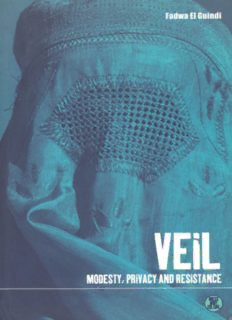
Veil: Modesty, Privacy and Resistance (Dress, Body, Culture) PDF
Preview Veil: Modesty, Privacy and Resistance (Dress, Body, Culture)
Veil Dress, Body, Culture Series Editor Joanne B. Eicher, Regents’ Professor, University of Minnesota Advisory Board: Ruth Barnes,Ashmolean Museum, University of Oxford Helen Callaway,CCCRW, University of Oxford James Hall,University of Illinois at Chicago Beatrice Medicine,California State University, Northridge Ted Polhemus,Curator, “Street Style” Exhibition, Victoria & Albert Museum Griselda Pollock,University of Leeds Valerie Steele,The Museum at the Fashion Institute of Technology Lou Taylor,University of Brighton John Wright,University of Minnesota Books in this provocative series seek to articulate the connections between culture and dress which is defined here in its broadest possible sense as any modification or supplement to the body. Interdisciplinary in approach, the series highlights the dialogue between identity and dress, cosmetics, coiffure, and body alterations as manifested in practices as varied as plastic surgery, tattooing, and ritual scarification. The series aims, in particular, to analyze the meaning of dress in relation to popular culture and gender issues and will include works grounded in anthropology, sociology, history, art history, literature, and folklore. ISSN: 1360-466X Previously published titles in the Series Helen Bradley Foster,“New Raiments of Self”: African American Clothing in the Antebellum South Claudine Griggs,S/he: Changing Sex and Changing Clothes Michaele Thurgood Haynes,Dressing Up Debutantes: Pageantry and Glitz in Texas Dani Cavallaro and Alexandra Warwick,Fashioning the Frame: Boundaries, Dress and the Body Thomas S. Abler,Hinterland Warriors and Military Dress: European Empires and Exotic Uniforms DRESS, BODY, CULTURE Veil Modesty, Privacy and Resistance Fadwa El Guindi Oxford•New York First published in 1999 by Berg Editorial offices: 150 Cowley Road, Oxford, OX4 1JJ, UK 70 Washington Square South, New York, NY 10012, USA © Fadwa El Guindi 1999 All rights reserved. No part of this publication may be reproduced in any form or by any means without the written permission of Berg. Berg is an imprint of Oxford International Publishers Ltd. Library of Congress Cataloging-in-Publication Data A catalogue record for this book is available from the Library of Congress. British Library Cataloguing-in-Publication Data A catalogue record for this book is available from the British Library. ISBN 1859739245(Cloth) 1859739296(Paper) Typeset by JS Typesetting, Wellingborough, Northants. Printed in the United Kingdom by Biddles Ltd, King’s Lynn. It is hoped that this book equally reaches those who decided to veil, those who refused to unveil, those who refused to veil, those who traditionally always veiled, and those who never ever veiled. This page intentionally left blank Contents Transliteration and Translation ix Preface xi PPPPPaaaaarrrrrttttt 11111::::: VVVVVeeeeeiiiiillllliiiiinnnnnggggg iiiiinnnnn PPPPPeeeeerrrrrssssspppppeeeeeccccctttttiiiiivvvvveeeee 11111 Introduction 3 22222 The Veil in Comparative Tradition 13 33333 Ideological Roots to Ethnocentrism 23 PPPPPaaaaarrrrrttttt 22222::::: DDDDDrrrrreeeeessssssssss,,,,, “““““LLLLLiiiiibbbbbaaaaasssss””””” aaaaannnnnddddd “““““HHHHHiiiiijjjjjaaaaabbbbb””””” 44444 The Anthropology of Dress 49 55555 Sacred Privacy 77 66666 The Veil in Social Space 97 77777 The Veil Of Masculinity 117 88888 The Veil Becomes a Movement 129 99999 The Sacred In The Veil: Hijab 147 PPPPPaaaaarrrrrttttt 33333::::: TTTTThhhhheeeee RRRRReeeeesssssiiiiissssstttttaaaaannnnnccccceeeee ooooofffff ttttthhhhheeeee VVVVVeeeeeiiiiilllll 1111100000 Reactions To The New Trend 161 1111111111 Contexts Of Resistance 169 1111122222 Veiling And Feminism 177 Notes 187 Bibliography 215 Index 235 This page intentionally left blank Transliteration and Translation No system of transliteration is followed, except for the HAMZA and ‘AYN, which are marked here by the apostrophe as a convenience to nonspecialists. Although some Arabic words or names, such as Mecca, Muhammed or Koran, have become common English words, in this book I use the spelling adopted by the American Journal of Islamic Social Sciences to approximate better the Arabic pronunciation of these words, so that they are spelled Makka, Muhammad, and Qur’an. Most Arabic words are printed in Italics. In some instances, when it is relevant to the meaning, I specify the syllable stress in parentheses following an Arabic word. Also, for each new Arabic word, its triliteral root follows it in parentheses. I carefully scrutinized existing English translations of the Qur’anic text relevant to my analysis, and examined it against the context of the other sources utilized – the original Arabic Hadith narratives and the Arabic Tafsir, ethnography and historical accounts. I discovered that often shades of mean- ings and nuances embedded in the original text are lost in the translations or slightly modified – enough to alter the meanings significantly for this anthropological analysis. Possibly it is some English-translated segments that are responsible for recurring clichés in scholarship, particularly on charged topics such as women and dress. Most translation of the original Arabic Qur’anic and Hadith text and of other non-Islamic Arabic sources is my own. ix
Description: